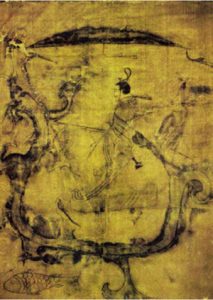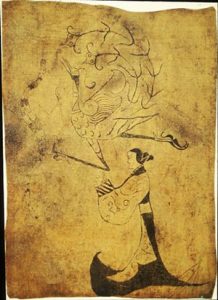
Eastern Zhou man fighting a dragon (ca. 300 BC)
Central Asian cavalry attacks
In 771 BC, skillful fighters from the northwest invaded Zhou Dynasty China; they may have been the ancestors of the Huns. These Central Asians had figured out how to ride horses in war, and wanted to use their new cavalry to conquer northern China. The Zhou system of fighting from chariots wasn’t up to fighting these new horse-riding armies. So the Zhou emperors retreated towards the Pacific Ocean and made a new capital at Luoyang, further east. So we call this period the Eastern Zhou.
More about cavalry
The earlier Zhou Dynasty
Lots more China articles
Spring and Autumn Period
Historians call the first three hundred years of the Eastern Zhou period the Spring and Autumn period because it was a good time for China. Many philosophers, like Confucius and Lao-Tzu, were working in China at this time.
Confucius and Lao-Tzu
Farmers invented the mold-board for their plows. Tool-makers in China learned how to use iron to make tools at this time; they probably learned from iron-workers in West Asia, maybe by way of India or Central Asia. Chinese traders started to travel to Korea.
What is a mold-board?
History of iron
History of Korea

Eastern Zhou woman with phoenix bird (ca. 300 BC)
Warring States Period
But iron also made good weapons, and the 200 little states began to fight each other all the time. Historians call the period from 481 to 221 BC the Warring States period. By this time, Chinese armies had learned from the Central Asians how to ride horses into battle. But they had trouble breeding good horses in China, where the climate wasn’t right for it.
Where do horses come from?
The Silk Road gets started
Chinese armies bought most of their horses from Sogdian traders. Chinese spinners and weavers – mainly women – started to produce a lot more silk cloth in order to trade it to the Sogdians for the horses, and for high-quality iron. So Silk Road trade became much more important to China during the Warring States period. Trade went eastward too, as ships started to sail between China, Korea, and Japan.
Who are the Sogdians?
History of silk
What is the Silk Road?
The end of the Eastern Zhou
By about 300 BC, there were only seven big states left. Soon after that, in 256 BC, the Zhou emperors lost power, and the only rulers of China were the kings of the seven states. These kings fought among themselves until the king of Qin, the strongest state, succeeded in making himself emperor and established the Qin Dynasty.
Go on to the Qin Dynasty (221-206 BC)
Bibliography and further reading about the Zhou dynasty: